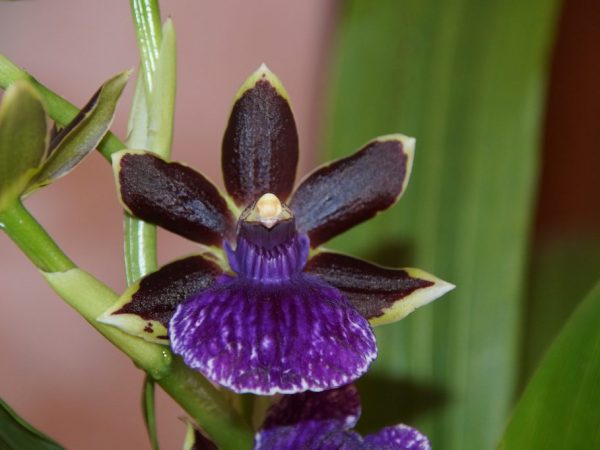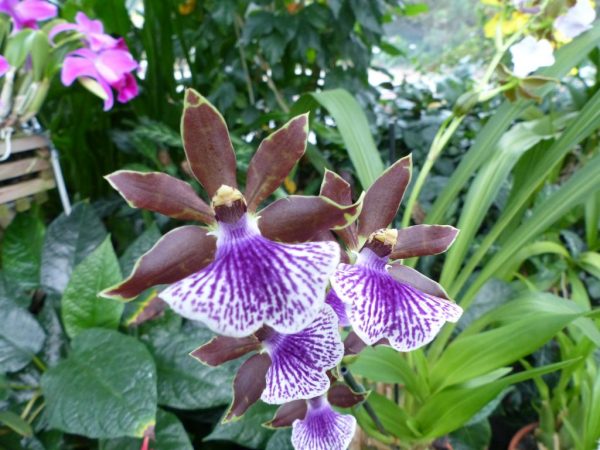Zygopetalum Orchid
The Zygopetalum Orchid is one of the eccentric plant species with lush flowering and delicate aroma. It is an epiphytic species that can also live and reproduce in soil. It is not so difficult to create the right conditions for its cultivation.

Zygopetalum Orchid
Description of the variety
This flower is most often found in the hot countries of Latin America.
The genus Zygopetalum orchids are large plants with white, purple and green flowers and exotic spotted petals. This flower has a delicate aroma, especially in the morning.
It grows for about 7 weeks. The rest period is not pronounced, most often it occurs in the winter. During this period, it is important to stop watering and lower the temperature and humidity.
Main types
The original type of Zygopetalum is rarely found in an ordinary flower shop, most often interspecific hybrids are presented.
Characteristics of different types:
- Zygopetalum maculatum. The peduncle at home grows up to 40 cm long with 8-12 flowers 4-5 cm in diameter. Petals and sepals are oblong, with a slight extension at the tips. The color is greenish, with burgundy specks. Longitudinal purple stripes are clearly visible on the white lip.
- Zygopetalum pedicellatum. This species has a narrow white lip with many purple dots throughout;
- Zygopetalum maxillare. It has a long peduncle, about 35 cm, with 5-8 large flowers up to 6 cm in diameter. At the bottom there are 2 sepals of burgundy-brown color with small green blotches. In the middle of the base, the 3rd sepal and true petals are also burgundy brown. The lip is deep purple at the base and purple-white at the tip.
- Zygopetalum triste. At home, the peduncle grows medium in size, about 25 cm, flowers have a diameter of 5-6 cm. The plant has narrow petals and maroon sepals with green spots at the base. The petal is snow-white, with blurred purple veins.
- Zygopetalum pabstii. It is the largest species of the genus. Peduncle reaches 90 cm, flowers 10 cm in diameter. Petals and sepals are the same as in other representatives of this species. The white lip is completely blurred with purple veins.
- Zygopetalum microphytum. This is a dwarf species, the peduncle of which reaches a size of 15-25 cm, flowers are 2.5 cm in diameter. Petals are green, sepals with maroon-brown spots. The lip is white, with small purple streaks at the very base.
Growing
A plastic or ceramic pot is suitable for growing. For better ventilation, holes are made on the sides. Expanded clay or clay shards are suitable for drainage. A special substrate is used for orchids. Sod land, dry leaves and peat are added to the soil.
Reproduction methods
Florists at home propagate this species by dividing the rhizome (rhizome). Each separated root part must have at least 3 pseudobulbs. The slices are dried, and then sprinkled with chopped charcoal.
Care
Caring for the Zygopetalum orchid involves creating conditions as close as possible to their natural habitat.

Zygopetalum care
Illumination
The plant is given bright and diffused lighting, but without direct sunlight. He is most comfortable on the east or west windowsill.
Lack of lighting leads to the death of flower buds, and an excess provokes the rapid growth of peduncles, young pseudobulbs are suspended in development and do not have time to mature well. Defective sprouts appear that are not able to bloom in the future.
Temperature regime
The optimum temperature during the day is 16-24 ° С, at night - 14 ° С. This regime is observed all year round. In the summer, the orchid is transferred to the balcony.
Priming
The primer must be highly breathable. The roots of such an orchid grow into any porous surface (for example, clay), and therefore difficulties arise during transplantation. A small layer of sphagnum or coconut fiber is laid on top of the roots.
Watering
Water for irrigation should be filtered and warm. The substrate is maintained in a slightly moist state, preventing overflow or drying out, since this species is prone to rotting of the root system. Pot for 20-30 min. immersed in a large container of water. It is pulled out and let the excess water drain, then it is returned to its usual place.
Air humidity
The most suitable is a humidity in the range of 75-100%. Such an indicator is obtained using a steam generator or a household air humidifier.
Fertilizer
Usually, the flower is fertilized during the period of rapid growth every 2-3 weeks. They use special fertilizers for orchids, but in smaller quantities.
Periodically, the leaves are sprayed with a diluted solution of the drug: 1.4 parts of the proportion indicated on the package. The flower does not like fertilizers containing potassium and phosphate salts.
Transfer
Zygopetalum orchid transplant is carried out if young shoots do not fit into the container. Any intervention in the root system is accompanied by severe stress and can provoke disease. Dry pseudobulbs and dry or rotten roots must be removed.
Diseases and pests
The Zygopetalum orchid species is prone to root rot. By providing proper watering, this problem can be avoided.
Pests such as snails and slugs gnaw holes in the leaves - they are collected from the plant by hand.
If a spider mite is found, the foliage is washed several times.
Prophylaxis
For the prevention of pests, the plant is treated with a fungicide. After transplanting or pruning, the roots are treated with crushed activated or charcoal.
Conclusion
It is imperative to follow the basic rules for the care and transplantation of the Zygopetalum orchid so that the plant blooms and pleases with a beautiful appearance.


